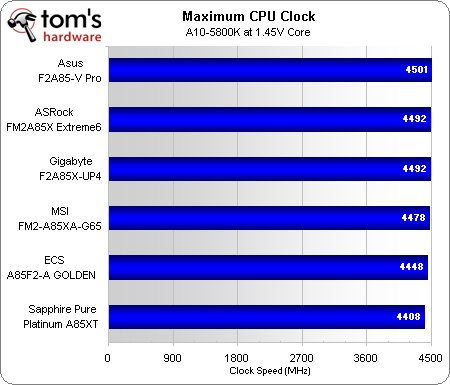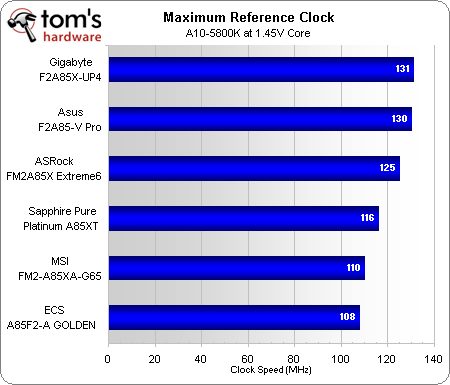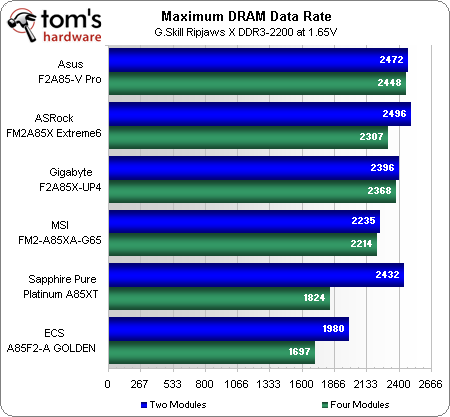Six Socket FM2 Motherboards For AMD's Trinity APUs
After just one generation, Socket FM1 is dead. We test six Socket FM2-based motherboards able to take AMD's newest APUs built using the Trinity architecture. Can any of these platforms, armed with AMD A85X Fusion Controller Hubs, get us to upgrade?
Overclocking
| BIOS Frequency and Voltage settings (for overclocking) | |||
|---|---|---|---|
| Row 0 - Cell 0 | ASRock FM2A85X Extreme6 | Asus F2A85-V Pro | ECS A85F2-A GOLDEN |
| Reference Clock | 100-136 MHz (1 MHz) | 90-300 MHz (1 MHz) | 90-200 MHz (1 MHz) |
| CPU Multiplier | 14-63x (1x) | 8-63x (1x) | 5-63x (1x) |
| DRAM Data Rates | 800-1866 (266.6 MHz) | 800-2400 (266.6 MHz) | 800-2400 (266.6 MHz) |
| CPU Vcore | 0.60-1.55V (6.25 mV) | 0.68-2.08V (6.25 mV) | 1.50-1.98V (20 mV) |
| CPU NB | 0.60-1.55V (6.25 mV) | 0.50-1.90V (6.25 mV) | 1.30-1.80V (20 mV) |
| A85X Voltage | 1.10-1.40V (100 mV) | 1.10-1.40V (10 mV) | 1.11-1.21V (~35 mV) |
| DRAM Voltage | 1.17-1.80V (5 mV) | 1.35-2.135V (5 mV) | 1.20-2.01V (10 mV) |
| CAS Latency | 5-14 Cycles | 5-16 Cycles | 5-14 Cycles |
| tRCD | 5-19 Cycles | 2-19 Cycles | 2-19 Cycles |
| tRP | 5-19 Cycles | 5-19 Cycles | 5-19 Cycles |
| tRAS | 15-40 Cycles | 8-42 Cycles | 8-42 Cycles |
| BIOS Frequency and Voltage settings (for overclocking) | |||
|---|---|---|---|
| Row 0 - Cell 0 | Gigabyte F2A85X-UP4 | MSI FM2-A85XA-G65 | Sapphire Pure Platinum A85XT |
| Reference Clock | 100-200 MHz (1 MHz) | 90-190 MHz (1 MHz) | 100-300 MHz (1 MHz) |
| CPU Multiplier | 8-79x (1x) | 8-63x (1x) | 16-58x (1x) |
| DRAM Data Rates | 800-2400 (266.6 MHz) | 800-2133 (266.6 MHz) | 800-2133 (266.6 MHz) |
| CPU Vcore | 0.80-2.10V (6.25 mV) | 1.20-1.90V (12.5 mV) | 1.20-1.70V (6.25 mV) |
| CPU NB | 0.80-2.10V (6.25 mV) | 1.00-1.50V (12.5 mV) | 1.20-1.54V (6.25 mV) |
| A85X Voltage | 1.00-1.40V (10 mV) | 0.91-1.51V (~11.5 mV) | 1.10-2.30V (10 mV) |
| DRAM Voltage | 1.10-2.62V (10 mV) | 1.29-2.01V (15 mV) | 1.30-2.30V (10 mV) |
| CAS Latency | 5-16 Cycles | 5-16 Cycles | 5-14 Cycles |
| tRCD | 2-19 Cycles | 2-19 Cycles | 2-19 Cycles |
| tRP | 5-19 Cycles | 5-19 Cycles | 2-19 Cycles |
| tRAS | 8-42 Cycles | 8-42 Cycles | 8-40 Cycles |
Some motherboards have far broader frequency ranges than others, but a 300 MHz reference clock limit on Sapphire’s motherboard is about as realistic as a 300 MPH speedometer on a Honda Civic. PCIe and integrated GPU overclocking limits are far more restrictive.
Asus, ASRock, and Gigabyte support our 45 x 100 MHz setting, with the difference between each vendor's board attributable to reference clock rounding errors.
Gigabyte reaches the highest reference clock with its integrated GPU intact. The second-place Asus F2A85-V Pro achieves a 156 MHz base clock with full CPU stability, but reference clocks over 130 MHz destabilize the APU’s integrated Radeon HD engine. Similar problems on the PCIe bus would affect graphics cards in a similar manner.
The F2A85-V Pro take top honors in memory overclocking, allowing us to use its highest 24x memory multiplier with four DIMMs installed. ASRock doesn't support a high memory ratio, but the board is able to reach a high data rate through increases in reference clock.
Current page: Overclocking
Prev Page Power, Heat, And Efficiency Next Page Of Six Socket FM2 Boards, Two Rise To The TopGet Tom's Hardware's best news and in-depth reviews, straight to your inbox.
-
buzznut And I would penalize Asrock for the brown PCB. Its an otherwise nice looking board, but this is a trend I don't care for.Reply -
Cryio Why, why do you keep posting Skyrim as being a DirectX11 title? It IS NOT. It's just DX9Reply -
Crashman CryioWhy, why do you keep posting Skyrim as being a DirectX11 title? It IS NOT. It's just DX9Why don't you point to where you see that?Reply
-
Sakkura CrashmanWhy don't you point to where you see that?Sneaky, lol. Now he's going to be downvoted.Reply -
Crashman SakkuraSneaky, lol. Now he's going to be downvoted.Not sneaky, I just see a lot of sniping in here. I checked the article and didn't find it, and I really need to find it before I can gripe at the person who made the final revisions to this article. His comment could be completely false for all I know...Reply -
Darkerson buzznutAnd I would penalize Asrock for the brown PCB. Its an otherwise nice looking board, but this is a trend I don't care for.Penalizing a company over a PCB's color is asinine and petty. Even if you have a case with an acrylic window, do you stare into your PC all day and night? If so, that is trend I don't care for.Reply
There are much more important things to worry about, like quality, price, and features, to name a few... -
cangeliniI fixed the typo earlier tonight guys, thanks."Adoby Creative Suite"Reply
just one?
:lol:
who cares, good job to crash and the rest of the crew . . .
edit: i had to fix a typo . .oh karma! -
cangelini looniam"Adoby Creative Suite"just one? who cares, good job to crash and the rest of the crew . . .edit: i had to fix a typo . .oh karma!Heh, apparently, editing motherboard round-ups in a Thanksgiving food coma is not conducive to catching typos. Got that one as well--thanks looniam! :)Reply



